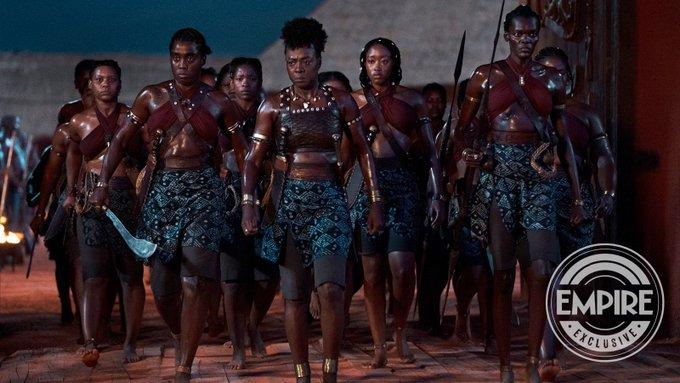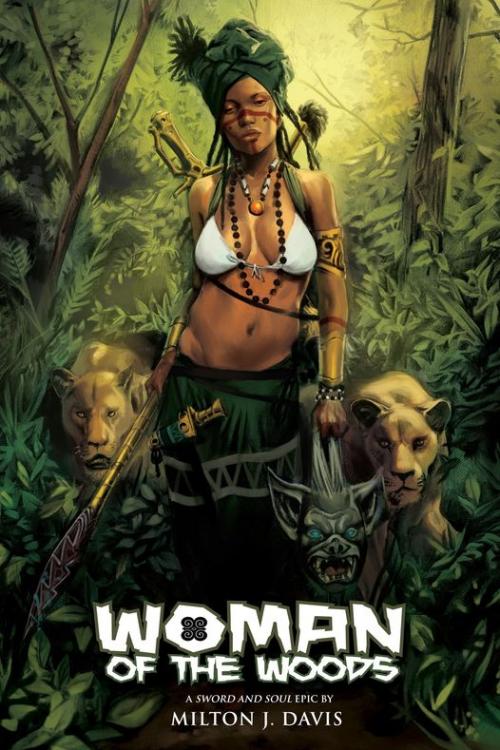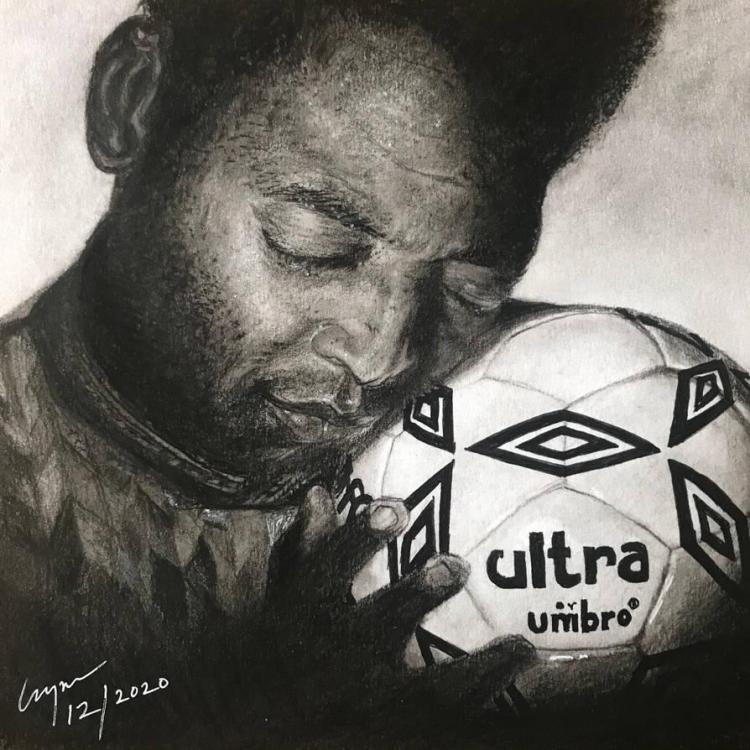Search the Community
Showing results for 'the woman king' in status updates posted by richardmurray.
Found 20 results
-
The private eye
https://www.deviantart.com/hddeviant/art/1047161895The woman
https://www.deviantart.com/hddeviant/art/1047162732the secretary
https://www.deviantart.com/hddeviant/art/1047163539for the invitational
https://www.deviantart.com/xyron7777777/journal/Week-4-Folder-Open-AND-Poetry-Challenge-1044434074
-
King of Dead Horses Ring
coloring page
https://www.deviantart.com/hddeviant/art/The-King-Of-Dead-Horses-Ring-b-w-997831321
adoptable page
https://www.deviantart.com/hddeviant/art/The-King-Of-Dead-Horses-Ring-adoptable-997831587 -
Who is the First Woman? Meet our new graphic novel hero!
Artemis [ https://www.nasa.gov/specials/artemis/ ] is the first step in the next era of human exploration. This time when we go to the Moon, we’re staying, to study and learn more than ever before. We’ll test new technologies and prepare for our next giant leap – sending astronauts to Mars.With today’s release of our graphic novel First Woman: NASA’s Promise for Humanity [ https://www.nasa.gov/CallieFirst/ ; free to read: ] you don’t have to wait to join us on an inspiring adventure in space.
Meet Commander Callie Rodriguez, the first woman to explore the Moon – at least in the comic book universe.
In Issue No. 1: Dream to Reality, Callie, her robot sidekick RT, and a team of other astronauts are living and working on the Moon in the not-too-distant future. Like any good, inquisitive robot, RT asks Callie how he came to be – not just on the Moon after a harrowing experience stowed in the Orion capsule – but about their origin story, if you will.
From her childhood aspirations of space travel to being selected as an astronaut candidate, Callie takes us on her trailblazing journey to the Moon.
As they venture out to check on a problem at a lunar crater, Callie shares with RT and the crew that she was captivated by space as a kid, and how time in her father’s autobody shop piqued her interest in building things and going places.
Callie learned at a young age that knowledge is gained through both success and failure in the classroom and on the field.
Through disappointment, setbacks, and personal tragedy, Callie pursues her passions and eventually achieves her lifelong dream of becoming an astronaut – a road inspired by the real lives of many NASA astronauts living and working in space today.
Callie''s official page
free to read or listen
https://www.nasa.gov/CallieFirst/Video Trailer
First Book Audio
URL
https://nasa.tumblr.com/post/663314232247549952/who-is-the-first-woman-meet-our-new-graphic-novel
Episode 2 cover page, use links above to read or listen to more
Ask Mission Control agents a question
https://nasa.tumblr.com/ask
more about them -
The Labors of Judasa is a history in the Chronicle of The Four King in the Tarikh Rohoregens. No one has a complete Tarikh Rohoregens, but recently this Incomplete Labors of Judasa in the Chronicle of The Four King was discovered.
https://www.deviantart.com/hddeviant/art/An-Incomplete-Labors-of-Judasa-970676145
Audiobookhttps://www.kobo.com/audiobook/an-incomplete-labors-of-judasa-from-a-griot
A Runic Remnant Of The Labors Of Judasa
Colored
https://www.deviantart.com/hddeviant/art/Orc-Tofusenshi-Dtiys-2023-Color-970678947
Coloring
https://www.deviantart.com/hddeviant/art/orc-tofusenshi-dtiys-2023-blackandwhite-970678468
Cento
https://www.deviantart.com/hddeviant/art/An-Incomplete-Labors-of-Judasa-Cento-970677156Video Excerpts - the same on different platforms
TUMBLR
TikTok
@richardmurraytiktok The Labors of Judasa is a history in the Chronicle of The Four King in the Tarikh Rohoregens. No one has a complete Tarikh Rohoregens, but recently this Incomplete Labors of Judasa in the Chronicle of The Four King was discovered. https://www.deviantart.com/hddeviant/art/An-Incomplete-Labors-of-Judasa-970676145 Audiobook https://www.kobo.com/us/en/audiobook/an-incomplete-labors-of-judasa-from-a-griot A Runic Remnant Of The Labors Of Judasa Colored https://www.deviantart.com/hddeviant/art/Orc-Tofusenshi-Dtiys-2023-Color-970678947 Coloring https://www.deviantart.com/hddeviant/art/orc-tofusenshi-dtiys-2023-blackandwhite-970678468 Cento https://www.deviantart.com/hddeviant/art/An-Incomplete-Labors-of-Judasa-Cento-970677156 #rmtja #rmaalbc #kobo #audiobook #richardmurray #black #artist #poetry #calligraphy ♬ original sound - richardmurraytiktok Youtube
-
Lupita Nyong'o On Why She Decided Not To Star In 'The Woman King'
Bre Williams
October 19, 2022Lupita Nyong’o is talking about why she decided to not star in The Woman King.
The actress was set to star alongside Davis in the upcoming historical film The Woman King. But back in 2020, the actress walked away from the film in which she was to play an Agojie warrior.
In a new interview with The Hollywood Reporter, Nyong’o opened up about why she decided against starring in Gina Prince-Bythewood’s film.
Nyong'o didn't feel like the role was right for her.
According to IndieWire, Nyong’o was set to play an Agojie warrior in The Woman King starring Viola Davis, who also produces. The Agojie tribe inspired the fictional Dora Milaje female army in Black Panther.After she was cast in the film, the actress made a short documentary about the Agojie tribe called “Warrior Women With Lupita Nyong’o.”
Per The Hollywood Reporter, the Academy Award winner “grapples uncomfortably with the tribe’s legacy of violence.” After the documentary, Nyong’o decision to exit The Woman King though she hasn’t specifically revealed why.“It was very amicable, the departure from it,” Nyong’o said. “But I felt it wasn’t the role for me to play.”
Thuso Mbedu took over the role Nyong’o was slated to play.
After her departure, Lupita Nyong’o’s role was given to Thuso Mbedu.In addition to The Woman King, Nyong’o also exited the upcoming Apple TV+ series Lady in the Lake, which stars Natalie Portman. Moses Ingram replaced her in that series.
“I’m desperate for small projects,” Nyong’o told THR. “They’re harder to get off the ground, they’re harder to stay on track. Bigger movies elbow them out of the way. The pandemic and the fiscal stress on the industry has made it even harder for those movies to get made.”
Nyong'o is currently balancing large projects with smaller independent roles.
“I think to be culturally prosperous, to be artistically prosperous as a people, is to have options. I personally love a good Marvel movie, but it doesn’t take me away from really wanting the little character-driven film,” the Us actress shared. “I believe in the fight for those things to be kept alive because the one thing we always want, the ultimate privilege, is choice.”She concluded, “It becomes a philosophical question about what is art and what is its purpose. I believe that art plays a role in moving the people that experience it, and a lot of people are moved by Marvel. Is you being moved by this thing less important than me being moved by Picasso?”
Bre Williams
October 19, 2022ARTICLE
https://shadowandact.com/lupita-nyongo-on-why-she-decided-not-to-star-in-the-woman-king
THE BLACK DRAGON'S REVENGE - RON VAN CLIEF - FULL HD MARTIAL ARTS MOVIE IN ENGLISH
imdb
https://www.imdb.com/title/tt0072858/?ref_=nm_flmg_act_16
film
LINK
https://www.youtube.com/watch?v=VeOoWRtASY4Is Kanye Finally CANCELED? from Bad Faith
LINK
https://youtu.be/wxHAm-bgFyM
Referral
https://twitter.com/msolurin/status/1580952441839026179
Art Block and Burnout from chrissa bug
LINK
https://youtu.be/e_tYHhkjC4s
REFERRAL
https://www.deviantart.com/chrissabug/status-update/New-Video-about-Art-Block-93374057228 Stories You Can Read Online for Black History Month
“Anything Could Disappear“
By Danielle Evans
Electric Literature
https://electricliterature.com/anything-could-disappear-danielle-evans/“Drinking Coffee Elsewhere“
By Z.Z. Packer
The New Yorker
https://www.newyorker.com/magazine/2000/06/19/drinking-coffee-elsewhere“The Era“
By Nana Kwame Adjei-Brenyah
Guernica
https://www.guernicamag.com/the-era/“Suicide, Watch“
By Nafissa Thompson-Spires
Dissent Magazine
https://www.dissentmagazine.org/article/suicide-watch-heads-colored-people-social-media“French Absolutism“
By Brandon Taylor
Joyland
https://joylandmagazine.com/fiction/french-absolutism/“What’s For Sale“
By Nicole Dennis-Benn
Kweli Journal
http://www.kwelijournal.org/fiction/2014/5/14/whats-for-sale-by-nicole-y-dennis-benn?rq=What's“Sunflowers“
By Bryan Washington
Boston Review
http://bostonreview.net/fiction/bryan-washington-sunflowers“Dangerous Deliveries“
By Sidik Fofana
Epiphany
https://epiphanyzine.com/features/dangerous-deliveries-fofana“Williamsburg Bridge“
By John Edgar Wideman
Harper’s Magazine
https://harpers.org/archive/2015/11/williamsburg-bridge/“The Key“
By Nnedi Okorafor
Enkare Review
https://enkare.org/2016/11/14/key-nnedi-okorafor/“Milk Blood Heat“
By Dantiel W. Moniz
Ploughshares
https://www.pshares.org/issues/spring-2018/milk-blood-heat“Bear Bear Harvest“
By Venita Blackburn
Virginia Quarterly Review
https://www.vqronline.org/fiction/2018/12/bear-bear-harvest“Beg Borrow Steal“
By Maurice Carlos Ruffin
Kenyon Review Online
https://kenyonreview.org/kr-online-issue/2015-summer/selections/maurice-carlos-ruffin-342846/“How to Kill Gra’ Coleman and Live to Tell About It (Vauxhall, NJ, c. 1949)“
By Kim Coleman Foote
Missouri Review
https://www.missourireview.com/how-to-kill-gra-coleman-and-live-to-tell-about-it-vauxhall-nj-c-1949-by-kim-coleman-foote/“Allentown, Saturday“
By Gabriel Bump
Brooklyn Rail
https://brooklynrail.org/2020/06/fiction/Allentown-Saturday“Books and Roses“
By Helen Oyeyemi
Granta
https://granta.com/books-and-roses/“God’s Gonna Trouble the Water“
By Randall Kenan
Oprah Magazine
https://www.oprahmag.com/entertainment/books/a33350187/randall-kenan-short-story-gods-gonna-trouble-the-water/“What It Means When a Man Falls From the Sky“
By Lesley Nneka Arimah
Catapult
https://catapult.co/stories/some-mathematicians-remove-pain-some-of-us-deal-in-negative-emotions-we-all-fix-the-equation-of-a-person“The City Born Great“
By N.K. Jemisin
Tor.com
https://www.tor.com/2016/09/28/the-city-born-great/“202 Checkmates“
By Rion Amilcar Scott
Electric Literature
https://electricliterature.com/202-checkmates-by-rion-amilcar-scott/“All This Want and I Can’t Get None“
By Tia Clark
Joyland
https://joylandmagazine.com/fiction/all-this-want-and-i-cant-get-none/“Wet Paper Grass“
By Jasmon Drain
Terrain
https://www.terrain.org/fiction/26/drain.htm“Emperor of the Universe“
By Kaitlyn Greenidge
Kweli Journal
http://www.kwelijournal.org/fiction/2014/10/10/emperor-of-the-universe-by-kaitlyn-greenidge“Ark of Light“
By Victor LaValle
Lightspeed Magazine
https://www.lightspeedmagazine.com/fiction/ark-of-light/“False Cognates“
By Ladee Hubbard
Guernica
https://www.guernicamag.com/false-cognates-1991/“Whiskey & Ribbons“
By Leesa Cross-Smith
Carve Magazine
https://www.carvezine.com/story/2011-fall-cross-smith“A Selfish Invention“
By Donald Quist
Storychord
http://www.storychord.com/2017/03/issue-140-donald-edem-quist-tracy.html“Best Features“
By Roxane Gay
Barrelhouse
https://www.barrelhousemag.com/onlinelit/2010/11/1/best-featuresARTICLE
https://chireviewofbooks.com/2021/02/01/28-stories-you-can-read-online-for-black-history-month/ -
Lupita Nyong'o On Why She Decided Not To Star In 'The Woman King'
Bre Williams
October 19, 2022Lupita Nyong’o is talking about why she decided to not star in The Woman King.
The actress was set to star alongside Davis in the upcoming historical film The Woman King. But back in 2020, the actress walked away from the film in which she was to play an Agojie warrior.
In a new interview with The Hollywood Reporter, Nyong’o opened up about why she decided against starring in Gina Prince-Bythewood’s film.
Nyong'o didn't feel like the role was right for her.
According to IndieWire, Nyong’o was set to play an Agojie warrior in The Woman King starring Viola Davis, who also produces. The Agojie tribe inspired the fictional Dora Milaje female army in Black Panther.After she was cast in the film, the actress made a short documentary about the Agojie tribe called “Warrior Women With Lupita Nyong’o.”
Per The Hollywood Reporter, the Academy Award winner “grapples uncomfortably with the tribe’s legacy of violence.” After the documentary, Nyong’o decision to exit The Woman King though she hasn’t specifically revealed why.“It was very amicable, the departure from it,” Nyong’o said. “But I felt it wasn’t the role for me to play.”
Thuso Mbedu took over the role Nyong’o was slated to play.
After her departure, Lupita Nyong’o’s role was given to Thuso Mbedu.In addition to The Woman King, Nyong’o also exited the upcoming Apple TV+ series Lady in the Lake, which stars Natalie Portman. Moses Ingram replaced her in that series.
“I’m desperate for small projects,” Nyong’o told THR. “They’re harder to get off the ground, they’re harder to stay on track. Bigger movies elbow them out of the way. The pandemic and the fiscal stress on the industry has made it even harder for those movies to get made.”
Nyong'o is currently balancing large projects with smaller independent roles.
“I think to be culturally prosperous, to be artistically prosperous as a people, is to have options. I personally love a good Marvel movie, but it doesn’t take me away from really wanting the little character-driven film,” the Us actress shared. “I believe in the fight for those things to be kept alive because the one thing we always want, the ultimate privilege, is choice.”She concluded, “It becomes a philosophical question about what is art and what is its purpose. I believe that art plays a role in moving the people that experience it, and a lot of people are moved by Marvel. Is you being moved by this thing less important than me being moved by Picasso?”
Bre Williams
October 19, 2022ARTICLE
https://shadowandact.com/lupita-nyongo-on-why-she-decided-not-to-star-in-the-woman-king
THE BLACK DRAGON'S REVENGE - RON VAN CLIEF - FULL HD MARTIAL ARTS MOVIE IN ENGLISH
imdb
https://www.imdb.com/title/tt0072858/?ref_=nm_flmg_act_16
film
LINK
https://www.youtube.com/watch?v=VeOoWRtASY4Is Kanye Finally CANCELED? from Bad Faith
LINK
https://youtu.be/wxHAm-bgFyM
Referral
https://twitter.com/msolurin/status/1580952441839026179
Art Block and Burnout from chrissa bug
LINK
https://youtu.be/e_tYHhkjC4s
REFERRAL
https://www.deviantart.com/chrissabug/status-update/New-Video-about-Art-Block-93374057228 Stories You Can Read Online for Black History Month
“Anything Could Disappear“
By Danielle Evans
Electric Literature
https://electricliterature.com/anything-could-disappear-danielle-evans/“Drinking Coffee Elsewhere“
By Z.Z. Packer
The New Yorker
https://www.newyorker.com/magazine/2000/06/19/drinking-coffee-elsewhere“The Era“
By Nana Kwame Adjei-Brenyah
Guernica
https://www.guernicamag.com/the-era/“Suicide, Watch“
By Nafissa Thompson-Spires
Dissent Magazine
https://www.dissentmagazine.org/article/suicide-watch-heads-colored-people-social-media“French Absolutism“
By Brandon Taylor
Joyland
https://joylandmagazine.com/fiction/french-absolutism/“What’s For Sale“
By Nicole Dennis-Benn
Kweli Journal
http://www.kwelijournal.org/fiction/2014/5/14/whats-for-sale-by-nicole-y-dennis-benn?rq=What's“Sunflowers“
By Bryan Washington
Boston Review
http://bostonreview.net/fiction/bryan-washington-sunflowers“Dangerous Deliveries“
By Sidik Fofana
Epiphany
https://epiphanyzine.com/features/dangerous-deliveries-fofana“Williamsburg Bridge“
By John Edgar Wideman
Harper’s Magazine
https://harpers.org/archive/2015/11/williamsburg-bridge/“The Key“
By Nnedi Okorafor
Enkare Review
https://enkare.org/2016/11/14/key-nnedi-okorafor/“Milk Blood Heat“
By Dantiel W. Moniz
Ploughshares
https://www.pshares.org/issues/spring-2018/milk-blood-heat“Bear Bear Harvest“
By Venita Blackburn
Virginia Quarterly Review
https://www.vqronline.org/fiction/2018/12/bear-bear-harvest“Beg Borrow Steal“
By Maurice Carlos Ruffin
Kenyon Review Online
https://kenyonreview.org/kr-online-issue/2015-summer/selections/maurice-carlos-ruffin-342846/“How to Kill Gra’ Coleman and Live to Tell About It (Vauxhall, NJ, c. 1949)“
By Kim Coleman Foote
Missouri Review
https://www.missourireview.com/how-to-kill-gra-coleman-and-live-to-tell-about-it-vauxhall-nj-c-1949-by-kim-coleman-foote/“Allentown, Saturday“
By Gabriel Bump
Brooklyn Rail
https://brooklynrail.org/2020/06/fiction/Allentown-Saturday“Books and Roses“
By Helen Oyeyemi
Granta
https://granta.com/books-and-roses/“God’s Gonna Trouble the Water“
By Randall Kenan
Oprah Magazine
https://www.oprahmag.com/entertainment/books/a33350187/randall-kenan-short-story-gods-gonna-trouble-the-water/“What It Means When a Man Falls From the Sky“
By Lesley Nneka Arimah
Catapult
https://catapult.co/stories/some-mathematicians-remove-pain-some-of-us-deal-in-negative-emotions-we-all-fix-the-equation-of-a-person“The City Born Great“
By N.K. Jemisin
Tor.com
https://www.tor.com/2016/09/28/the-city-born-great/“202 Checkmates“
By Rion Amilcar Scott
Electric Literature
https://electricliterature.com/202-checkmates-by-rion-amilcar-scott/“All This Want and I Can’t Get None“
By Tia Clark
Joyland
https://joylandmagazine.com/fiction/all-this-want-and-i-cant-get-none/“Wet Paper Grass“
By Jasmon Drain
Terrain
https://www.terrain.org/fiction/26/drain.htm“Emperor of the Universe“
By Kaitlyn Greenidge
Kweli Journal
http://www.kwelijournal.org/fiction/2014/10/10/emperor-of-the-universe-by-kaitlyn-greenidge“Ark of Light“
By Victor LaValle
Lightspeed Magazine
https://www.lightspeedmagazine.com/fiction/ark-of-light/“False Cognates“
By Ladee Hubbard
Guernica
https://www.guernicamag.com/false-cognates-1991/“Whiskey & Ribbons“
By Leesa Cross-Smith
Carve Magazine
https://www.carvezine.com/story/2011-fall-cross-smith“A Selfish Invention“
By Donald Quist
Storychord
http://www.storychord.com/2017/03/issue-140-donald-edem-quist-tracy.html“Best Features“
By Roxane Gay
Barrelhouse
https://www.barrelhousemag.com/onlinelit/2010/11/1/best-featuresARTICLE
https://chireviewofbooks.com/2021/02/01/28-stories-you-can-read-online-for-black-history-month/
-
IT’S ALL ABOUT THE PITCH: ONE WOMAN’S MISSION TO HELP HER SISTER ENTREPRENEURS MATCH VISION WITH CAPITAL
by BLACK ENTERPRISE Jan. 26, 2023Shelly “Omi” Bell saw the struggle first-hand as an entrepreneur, so she created Black Girl Ventures to help all ideas from women entrepreneurs succeed.
Shelly “Omi” Bell remembers the day she was laid off from her computer science job. She decided at that moment that she had received her last pink slip.
“After I walked out of that job, I said to myself, ‘I won’t ever again put myself in a place where an employer can just lay me off for their own reasons. I have to make my own way.’”

PHOTO source
noneThat promise to herself led to the launch of Black Girl Ventures (BGV) in 2016. BGV is Bell’s crowdsourcing enterprise that provides women founders of color with direct access to capital and tools that can help them get through the initial stages of starting a business, create and meet key business milestones, and kick-start growth. < https://www.blackgirlventures.org/ >
“The motivation came from my journey,” explains Bell. “The news reported that Black women were launching businesses at six times the national average yet receiving less than 1% of venture capital. Instead, Black people depend on earned capital – our paychecks and savings.” Part of Bell’s funding came from her mother’s retirement.
A 2021 Harvard Business Review analysis confirms Bell’s point. More than 60% of Black women self-fund their startup costs—a high-risk gamble when only 29% of Black women entrepreneurs live in households with incomes over $75,000. High college debt and disparities in homeownership stack the deck further.
To change the narrative, Bell found inspiration in the fabled Harlem “rent parties” of an earlier era. She explains, “People would throw these fabulous house parties whenever landlords raised the rent. You’d pay at the door, and they’d use the money to cover the increase. The community came together to keep people in their homes.”
VIDEO- could not embed
View Transcript »
On-screen graphics:
Blue background with BLACK ENTERPRISE and Bank of America logos shown on screen.
Various images of Shelly “Omi” Bell appear.On-screen copy:
Shelly “Omi” Bell, Founder
Black Girl VenturesOn-screen copy:
Shelly “Omi” Bell, Founder
Black Girl VenturesOn-screen graphics:
Black Enterprise logo
“in partnership with Bank of America” logoShelly “Omi” Bell: I’m Shelly Omílàdé Bell, but I go by Omi, and I’m the founder and CEO of Black Girl Ventures.
Black Girl Ventures is a non-profit enterprise where we focus on creating access to capital, capacity, and community for Black and Brown women-identifying founders.
On-screen graphics:
Homepage of Black Girl Ventures' website
Change Agent Fellowship program page of Black Girl Ventures' website
The BGV Next Gen page of Black Girl Ventures' website
The Pitch Program page of Black Girl Ventures' websiteShelly “Omi” Bell: We have three main programs: An Emerging Leaders program is our change agent fellowship. We have our NextGen program, which is our HBCU program, and we have a pitch program, which is our signature program.
On-screen graphics:
Black Girl Ventures’ Raisify.co platformShelly “Omi” Bell: The audience votes with their dollars for the pitch that they favor.
On-screen graphics:
Various images of Black/African American women with microphones at the Black Girl Ventures’ pitch competitionsShelly “Omi” Bell: We take that capital, and we create a grant out of it, and we give it back to those founders. We also work with partners to either match the funding or give bigger prizes to the top three.
On-screen graphics:
Various images of Black Girl Ventures’ pitch competitionsShelly “Omi” Bell: And it’s not just the pitch competition that comes with BGV pitch; what is available to you is a new customer base and visibility, there’s coaching, and we also do deck review, which is an opportunity to gain more capital for your business.
We want to build a sustainable community practice.
On-screen graphics:
Various images of the Black Girl Ventures’ founder and employeesShelly “Omi” Bell: So, since the inception of BGV, we have funded over 300 founders, and this is direct funding to those founders. We’ve also directly impacted over 20,000 people through training.
Our partnership with Bank of America was specifically focused on communities, and the power of crowdfunding is the power of being able to build a community.
On-screen graphics:
Various images of Black/African American women
Short video clips of Black Girl Ventures’ pitch competitionsShelly “Omi” Bell: The importance of working with women, in general, is that women actually are the caretakers of the family.
We’re the ones that put the energy of the household on our back. So, when you serve a family, when you serve a woman, you are serving the community.
When you serve a woman, you are serving an entire family unit, not just one person. So, the importance of serving women, in general, is to be sure that we’re supporting an entire community and the future of generations to come.
Bell initially hosted small get-togethers in her southeast Washington, D.C. home, inviting local businesswomen to pitch to the group. “We voted for the best pitch and gave what we collected at the door back to the winner in cash.”
Those early gatherings eventually turned into the company’s signature program, BGV Pitch. The door charge is gone, but the concept is the same. Competitions are conducted virtually on Raisify, BGV’s online crowdsourcing platform. Funders who qualify (they must be in business for at least a year and generating revenue) tell the story of their business or product line to an online community of potential investors. “We let people vote with their dollars,” Bell says. “Then we take that capital, create grants with it and award the funds to businesses that stand out.”
Bell emphasizes that deep pockets aren’t required to be a contributor. “The BGV Pitch allows people to engage where they are. It could be $5 or $500. You can change somebody’s life in real-time.”
Bell’s strategic partnership with Bank of America has extended BGV’s reach and capacity. “With that help, we’ve created 120 new jobs and provided 1,040 technical assistance hours. Since we launched, BGV has funded 300 women entrepreneurs who, collectively, generate over $10M in revenue and support 3,000 jobs, making us the largest ecosystem builder for Black/Brown women founders on the East Coast.” BGV hopes to help more than 100,000 Black/Brown women founders by 2030.
“With the support of our partners, BGV is driving change and making a tangible impact in the community,” says Bell. She adds, “BGV is shooting for the moon, and we believe we can do it. There’s no doubt.”
Are you looking for a community that supports the growth of your business? Learn more about the resources BGV offers to kick-start or continue to elevate your business here. < https://www.blackgirlventures.org/ >
-

Photo source
(https://theblackpages815.wixsite.com/my-site/about)BLACK WOMAN’S DIRECTORY, ‘THE BLACK PAGES’ HELPS COMMUNITY FIND BLACK-OWNED BUSINESSES
Stacy JacksonFebruary 16, 2023Find all things Black-owned in this directory.
Courtney Wade is bringing the community together with The Black Pages, a directory she created for easier access to finding local Black-owned businesses.
According to Daily Journal, Wade was motivated to create the directory following the May 2020 killing of George Floyd.
“The community was in arrest, but they were looking for something and wanted to come together,” she said regarding the incident.
Wade observed the needs of the community and, alongside family members and other activists, she developed a festival as part of Juneteenth to celebrate the Black community. She initially imagined the directory as a way to merge the community with local businesses.
"As you go through the festival, there were so many businesses I didn’t know existed,” she said. “After talking to people in the area, especially the older population, they weren’t aware of that either.”
The Black Pages includes more than 70 local businesses and organizations.
“But the idea is for it to become a fully-functional thing,” she said. “So, wherever you go, you can find what you’re looking for.”
A new copy of the directory is published via a local printer around every six months.
Although the primary focus of the directory is Kankakee County, Wade has received involvement from multiple businesses outside the county.
“Overall, my focus and main job — besides my family — is bridging the gaps in the community,” Wade said. “Merging the needs of the community with the resources of the community.”
Wade and her team are working to continue the expansion and growth of the directory this year.
The directory will be available through Facebook and The Black Pages website. < https://theblackpages815.wixsite.com/my-site >
The cost for inclusion is $10, and businesses can reach out via email to submit information for directory inclusion. < theblackpages815@gmail.com >
-
Happy birthday all jarreau- king of vocaleze!!
one of my favorite al jarreau interpretations, best to start with this
Boogie down written by al jarreau
All or nothing at all - the love letter
happy valentines day:) he didn't write it, but his interpretation feels so good
There's no greater crime
Than wastin' your life
On a boat goin' nowhere
When you came along
You made it safe
For love to survive
I trusted and dreamed
And you came like I knew you would
I've been 'round before
But this feels so goodI could not walk by
I knew that I'd found
What's at the end of the rainbow
There's no place on earth I'd rather be
Than stayin' right here with you
It's not about luck
I don't need to knock on wood, no no
Been 'round before
But this feels so goodNight after night
It's so hard to believe
That I wake up each day next to you
Time after time
In the cold mornin' light it's good to know
It's good to know that it's trueThere's no greater sin
Than missin' your chance
But when it's starin' right at 'ya
That look in your eyes
Say everything and tells me I'm home
For once in my life
You know I don't feel misunderstood
Well I've been 'round before
Oh but this time you know it feels so sure
Been 'round before
But this feels so good
Been, been 'round before
This feels so goodYou all sing
So good, so good, so good
So good, so good, this feels so good
This is what I mean
Exactly what I am talking about
This feels so good
So good, so good so good
So good, so good
This feels so good
So good, so good, so good
So good -
SECRETS OF THE DEAD : THE WOMAN IN THE IRON COFFIN
Follow a team of forensic experts as they investigate the preserved remains of a young African American woman from 19th century New York and reveal the little-known story of early America’s free Black communities.
Notes are after the full video
official link
https://www.pbs.org/wnet/secrets/woman-in-the-iron-coffin-about-the-film/3923/
FULL VIDEO
NOTES
On October 4, 2011, construction workers were shocked to uncover human remains in an abandoned lot in the Elmhurst neighborhood of Queens, New York. So great was the level of preservation, witnesses first assumed they had stumbled upon a recent homicide. Forensic analysis, however, revealed a remarkably different story. Buried in an elaborate and expensive iron coffin, the body belonged to a young African American woman who died in the first half of the 19th century, before the Civil War and the federal abolishment of slavery. But who was she? Secrets of the Dead: The Woman in the Iron Coffin follows forensic archaeologist Scott Warnasch and a team of historians and scientists as they investigate this woman’s story and the time in which she lived, revealing a vivid picture of what life was like for free African American people in the North.
Noteworthy Facts
The iron coffin was created in 1848 by Almond Dunbar Fisk, a stove manufacturer from New York. The coffin was created to preserve bodies for sanitary storage and for transportation prior to modern embalming. The airtight coffins also preserved bodies well enough for legal identification purposes. Iron coffins were very expensive for the era and used by the wealthy and elite, including former first lady Dolley Madison, former President Zachary Taylor, and former Vice President John C. Calhoun.
New York, one of the largest slaveholding states, officially abolished slavery on July 4, 1827. Following the abolishment, freed African Americans began to establish communities in New York City, including the Queens community of Newtown (now Elmhurst), where a body was found at what was once the location of an African Methodist Episcopal church and burial ground.
The “Woman in the Iron Coffin” was first discovered by construction workers on October 4, 2011 and was believed to be a victim of a homicide. Archaeologists were called to the site on October 5, 2011, where they discovered metal fragments, suggesting the woman was buried more than 150 years ago.
From initial examinations, it was determined that the body was that of an African American woman, dressed in a long white nightgown with thick, knee-high socks and a hand-crafted comb that held a delicate knit cap on her head.
After examining the body and studying the 1850 Census of New York City, Warnasch determines that the remains likely belonged to Martha Peterson, a 26-year-old African American woman living in New York City in 1850. Peterson was the daughter of John and Jane Peterson, prominent figures in Newtown’s African American community.
Public records also noted that Martha Peterson lived with William Raymond, the brother-in-law, neighbor and business partner of Almond Dunbar Fisk, the iron coffin creator.
In 2016, the “Woman in the Iron Coffin” was given a proper burial by the Saint Mark African Methodist Episcopal Church of Jackson Heights.
Buzzworthy MomentsFor a non-evasive way to further examine the woman’s remains, Warnasch seeks the help of Prof. Jerry Conlogue to conduct a “virtual” autopsy. Using sophisticated computer software and hardware, Warnasch and Conlogue determine the woman was between 25 and 30 years old, and died from smallpox.
Forensic imaging specialist Joe Mullins creates a facial reconstruction of the “Woman in the Iron Coffin” by using a CT scan of the skull, digitally fixing the damaged parts of the skull, and incorporating age-and-ancestry-appropriate features from a database of thousands of body parts. To give back to the Queens community, Warnasch shares the image of the woman with members of the Saint Mark African Methodist Episcopal Church
Secrets of the Dead: The Woman in the Iron Coffin is a production of Impossible Factual. Directed by Adam Luria. Stephanie Carter is executive producer for Secrets of the Dead.
Photo still

Dogs in the wild
https://www.pbs.org/wnet/nature/collections/dogs-wild/
FULL EPISODE
Meet the family - full episode
CLIPS
Meet the family
African wild dog vote with sneezes
Ethiopian wolf vs mole rat
Meet the world's smallest wild dog
Dhole pack coordinates attack on deer
Defending wild dogs
Urban foxes battle over territory
Secrets of success
IMAGE STILL

-
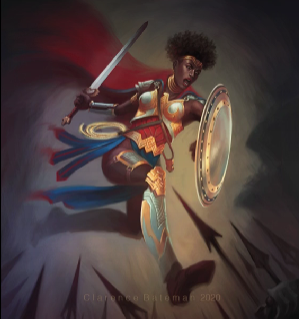
Title: Artwork process for ‘Nubia wonder woman’
Video Process
Artist: Clarence Bateman
https://www.deviantart.com/clarencebatemanart/art/Artwork-process-for-Nubia-Wonder-Woman-910623152Prior Post
https://aalbc.com/tc/profile/6477-richardmurray/?status=2092&type=status
Post with Clarence Bateman
-
Quoted from the author Milton j Davis @Milton not me
My novel Woman of the Woods was inspired by my research on the Mino of Dahomey, the same source of inspiration of The Woman King. It tells the story of Sadatina, a girl on the brink of becoming a woman living with her family in Adamusola, the land beyond the Old Men Mountains. But tragic events transpire that change her life forever, revealing a hidden past that leads her into the midst of a war between her people and those that would see them destroyed, the Mosele. Armed with a spiritual weapon and her feline 'sisters,' Sadatina becomes a Shosa, a warrior trained to fight the terrible nyokas, demon-like creatures that aid the Mosele in their war against her people.
https://www.mvmediaatl.com/product-page/woman-of-the-woods
-

HISTORY | SEPTEMBER 2022Was King Arthur a Real Person?
The story of Camelot and the Knights of the Round Table has captivated us for a thousand years. But is there any truth behind the tales?
By Joshua Hammer https://www.simonandschuster.com/authors/Joshua-Hammer/19043478Photographs by Jooney Woodward https://jooneywoodward.co.uk/information/
A cold, wind-driven rain soaks through my parka as I walk across a narrow foot-bridge that links the Cornwall mainland in southwest England to a rocky promontory overlooking the Bristol Channel. Far below this cantilevered span, waves crash against the cliffs and swirl inside a grotto known as Merlin’s Cave. Win Scutt, a burly, amiable archaeologist from nearby Plymouth, opens a gate and leads me down a path to the ruins of a medieval castle. Its fragmentary walls mark the lair where Richard, the 13th-century Earl of Cornwall and the brother of King Henry III, is said to have gathered with his followers to feast on mutton and ale and pay homage to a monarch who may never have existed: King Arthur.
The figure of Arthur first appeared in Welsh poetry in the late sixth and early seventh centuries, a hero who was said to lead the Britons in battle against Saxon invaders. But it wasn’t until the 12th century that he was first tied to this dramatic headland, known as Tintagel. In the Welsh cleric Geoffrey of Monmouth’s History of the Kings of Britain, which was written in 1136 and purported to trace Britain’s history back to its supposed founding by Trojan exiles, an almost certainly fictitious sixth-century king named Uther Pendragon sleeps with the beguiling Ygerna, the wife of a local duke, at her castle in Tintagel, after the magician Merlin turns Pendragon into a likeness of her husband. “That night she conceived Arthur, the most famous of men, who subsequently won great renown by his outstanding bravery,” Geoffrey wrote.
Scholars have universally dismissed Geoffrey’s text as a pseudo-history, woven from ancient Welsh folk tales and his febrile imagination. Still, many people at the time believed the story, and Richard, Earl of Cornwall, was so convinced Arthur was real that, in May 1233, he traded three prime estates for this treeless headland, which is separated from the mainland by an isthmus, and built a castle on it. “It had no function,” Scutt says, as he leads me through the stone ruins of the castle’s great hall. “It’s in a remote part of Cornwall that had no use to him. But he wanted to anchor his position in legend and history. He was the Earl of Cornwall—but he was also the successor of Arthur.”
King Arthur has never relinquished his hold on the imagination. Writers in Geoffrey’s wake added their own flourishes—the magical sword Excalibur, the Knights of the Round Table, Arthur’s romantic triangle with Queen Guinevere and Sir Lancelot, and Arthur’s mortal wound at the Battle of Camlann. Arthurian tales of courtly love, magic and martial bravery have been told and retold in countless versions over the centuries, from the earliest eulogistic stanzas in Welsh poetry to T.H. White’s 1958 novel The Once and Future King, from Sir Thomas Malory’s 15th-century Le Morte d’Arthur to the 2021 film The Green Knight, starring Dev Patel as Sir Gawain, a knight at Camelot, the legendary castle where Arthur held court. “There is something in the Arthur legend for everyone,” says Leah Tether, a professor of medieval studies at Bristol University and former president of the British branch of the International Arthurian Society, which regularly brings together scholars and other enthusiasts interested in Arthurian literature. The story of King Arthur, she says, “has got flawed characters with whom we can empathize, quests to achieve impossible goals, and an adaptable story line that fits the sociopolitical landscape of the time.” Raluca Radulescu, a professor of medieval literature at Bangor University in Wales, suggests Arthur’s perennial appeal is also tied to “a standard of moral integrity” that readers find inspirational, one “they cannot find in the world around them, but will discover in the stories of King Arthur.”The timeless popularity of the Arthur legend has overshadowed a central, unresolved question: Was there really a King Arthur, or at least a historical prototype upon whom Geoffrey’s hero is based? That’s what has brought me to Tintagel on this stormy winter morning. Scutt leads me down a grassy slope to the foundations of a dozen houses built on terraces overlooking the sea. Ralegh Radford, the English archaeologist who exposed these ruins in the 1930s, was reminded of similar structures at remote sites in Ireland, and after observing Christian symbols on ceramics found at the site he guessed the ruins were the remains of a Celtic monastery that existed between the fifth and seventh centuries.
Over the past four years, however, Scutt and his team from English Heritage, a nonprofit organization that administers more than 400 historical sites in Britain, have conducted their own research, and they’ve challenged Radford’s assessment of the site. They have excavated three additional houses and have also unearthed fragments of glass goblets from Spain, cups from Merovingian-era France, pottery from Tunisia and amphorae from Turkey used for storing wine or olive oil. Carbon dating, unavailable to Radford a century before, has confirmed the settlement existed in the sixth century. But rather than being a retreat for religious ascetics, Scutt believes that the site, with its protected position on the Cornwall coast, was a flourishing local stronghold. “This could have been home to a mercantile elite whose economy was based entirely on trade,” he says.
Tintagel, Scutt says, was likely home to several thousand people and controlled a territory that extended across modern-day Cornwall. He points out that while much of the British Isles had sunk into illiteracy and destitution during this period—commonly known as the Dark Ages—most residents at Tintagel lived in comfortable slate-roofed homes with sturdy wooden timbers and, in some cases, a second story. It’s not implausible, he argues, that a ruler or commander—perhaps one named Arthur—rose out of this society, and served as an inspiration for Geoffrey of Monmouth. The headland has given up other tantalizing clues, including a sixth-century stone slab with the mysterious word “Artognou” carved into it. Experts in Celtic, the language spoken in Britain at the time, dismiss its significance. But some insist the inscription is a variation of “Arthur.” The slab, they say, is a mark of the king’s realm.
When the legend of Arthur was born, Britain was in a state of collapse. The Roman Empire had made its first incursion into the British Isles in 55 B.C., eventually conquering much of the territory up to present-day Scotland. Its conquest and long rule was often violent, but the Romans also built roads and established towns such as Londinium and Durovernum Cantiacorum, today London and Canterbury. Throughout the Roman province of Britannia the quality of life largely improved.
Then, in A.D. 410, Rome, under siege at home from Visigoths, a Germanic tribe from Eastern Europe, withdrew its troops and plunged Britannia into chaos. Civil institutions vanished, the economy collapsed, and basic household goods became scarce. Saxon invasions terrorized the population, and Britannia fragmented into fiefdoms dominated by often brutal strongmen and their gangs. “Britain has kings, but they are tyrants . . . engaged in plunder and rape, but always preying on the innocent,” a British monk named Gildas wrote in the sixth century. Plague and drought struck the region, wiping out a significant part of the population.
“Britain was a failed state,” says Marc Morris, a British historian and author of 2021’s The Anglo Saxons: A History of the Beginnings of England: 400 to 1066. “It was a miserable time to be alive.”
Many historians believe that a heroic warrior likely rose during this period to lead the Britons, who had largely embraced Christianity, against the pagan Saxons. The Welsh poem Y Gododdin, written between A.D. 540 and 640, describes a fallen soldier by likening him to another called Arthur, which some scholars interpret as showing that a warrior named Arthur was so famous when the poem was written that the bravery of others could be measured by comparison. Around the same time, Gildas, the monk, described a British triumph at the Battle of Badon Hill, which he dated to “the year of my birth,” probably in the early sixth century. He didn’t mention Arthur (he called his hero Ambrosius Aurelianus), but three centuries later, around 830, a Welsh monk named Nennius, in his History of the Britons, described how a warrior named Arthur led the Britons to victory in 12 glorious battles against the Saxons. “The twelfth battle was on the mountain of Badon, in which there fell in one day 960 men from one charge of Arthur, and no one slew them except him alone, and in all battles he was the victor,” Nennius wrote.
Some scholars have pointed to Nennius’ account as evidence of Arthur’s existence. Yet Nicholas Higham, a retired medievalist at University of Manchester and the author of 2018’s King Arthur: The Making of the Legend, says the evidence is hardly conclusive. For one thing, the account was written 300 years after the Battle of Badon Hill was purported to take place. (Although Gildas’ text provides the only contemporaneous mention of the battle, other British histories, including the eighth-century Ecclesiastical History of the English People, describe the fighting in detail, and scholars are generally convinced that such a battle did take place.) For another, historians in the Middle Ages are widely known to have blended fact and fiction to advance a political or religious agenda. At a time when the Saxons were conquering Britain, Higham says, the Britons needed a “god-beloved warrior” to rally their spirits and restore the emergent nation to glory, and Nennius concocted a character to fit the bill. “Arthur was winning battles with the support of Jesus Christ and Mary against the Saxons,” he says. “The Saxons were presented as barbaric, dishonest and latecomers to Christianity.” To show that Arthur had roots in Roman culture, which was still widely admired, Higham argues, Nennius derived the name from Artorius, a general who gained fame in the Punic Wars in the third century B.C.
If Nennius established Arthur as a British hero, Geoffrey of Monmouth brought him to life. Born around 1090, possibly in Wales, and educated in Paris and Oxford, Geoffrey was ensconced as a bishop in Britain in the mid-1100s when he wrote, in Latin, perhaps the most influential book ever about Arthur. Like Nennius, Geoffrey had a political agenda: to show the superiority of the Celtic-speaking Britons, and by extension, the Welsh, who spoke the same language. “There were a lot of criticisms of the Welsh as being savages, barbarians,” says Morris. “Geoffrey invents a noble history for them, going back a hundred kings before Arthur.” A cipher in Nennius’ history, Arthur now became a Celtic-speaking warrior-king within a richly imagined narrative.
Geoffrey claimed that he’d gleaned details of Arthur’s life from an ancient Welsh history book shown to him by an Oxford archdeacon, but there’s no evidence such a book existed. There’s also no knowledge about what might have led him to set Arthur’s origin story at Tintagel, or if he ever visited the remote headland. “He would have known it as a very dramatic, rocky clifftop, a mystical place, a place that there were plenty of stories about,” says Higham. “But that’s all we can say.”
Geoffrey introduced Guinevere’s infidelity to Arthur, the wizard Merlin (a composite of earlier Welsh prophets) and a magical sword he called Caliburn (based on the Irish sword Caladbolg, a derivation of the Welsh Caledfwlch), which later became known as Excalibur. He ended the tale on an island called Avalon, where Arthur is carried by the enchantress Morgan le Fay after being “mortally injured” against the Saxons in the Battle of Camlann. Geoffrey apparently plucked this battle from The Welsh Annals, written in the late tenth century. This set of chronicles, an apparent blend of fact and fiction, established A.D. 537 as the year of “The Battle of Camlann, in which Arthur and Medraut”—or Mordred, who in later Arthurian tales becomes Arthur’s treacherous nephew and rival—“fell, and there was plague in Britain and Ireland.”
Geoffrey’s fantastical account had its share of skeptics. “It is quite clear that everything this man wrote about Arthur and his successors, and indeed his predecessors...was made up,” the medieval historian William of Newburgh wrote. Yet many Britons accepted it as the truth. In 1191 the monks of Glastonbury Abbey dug up a pair of skeletons in their churchyard and touted them as the remains of King Arthur and Queen Guinevere—a clever hoax to draw paying tourists to the abbey. By the 13th century, writes Morris in 2015’s A Great and Terrible King: Edward I and the Forging of Britain, “It was proof positive that the fabulous king about whom Geoffrey of Monmouth had written had once really existed.”
One true believer was King Edward I. In 1278, the monarch visited the grave site at Glastonbury and ordered the remains to be disinterred, partly to lay to rest the belief in some quarters that Geoffrey’s hero was superhuman and still alive—and thus could potentially challenge Edward for the throne. “There in two caskets were found the bones of the said king of wondrous size, and those of Guinevere, of marvellous beauty,” wrote a local observer. Afterward, the king and queen wrapped the skeletons in silk, placed the royal seal on them, and returned them to their graves.
From this point, the Arthur legend not only grew but became the dominant literary tale of medieval Europe. Monasteries and royal courts bought more than 1,000 copies of Geoffrey’s manuscript, making it the most popular text in the Middle Ages after the Bible. Richard Barber, an Arthurian scholar in Sussex, has personally tracked down 235 surviving copies. He might have found more, but when Henry VIII shuttered the country’s monasteries in the 1530s during his break with the Roman church, “A lot of them were torn up and used for wrapping pies,” Barber told me.
Meanwhile, Arthur’s legend traveled across the English Channel to France, thanks to the hugely influential 12th-century French poet Chrétien de Troyes. Possibly borrowing from Geoffrey and from Welsh folk tales, and writing under the patronage of the Plantagenets, the British-French dynasty founded by Henry II, de Troyes invented Sir Lancelot, Camelot and the Holy Grail, which he described as a “vessel” used by Jesus at the Last Supper. “The Arthur story began to take off,” says Barber. “One hundred years later, you’ve got Arthur in Germany and all around Italy.”
Manuscripts retelling the Arthur myth became so common that they were often discarded and recycled, and not only as pie-wrapping paper. One winter morning I visit the rare-book room at Bristol’s Central Library with Leah Tether, the University of Bristol medievalist. A library staff member brings us four leather-bound tomes written by the French philosopher Jean Gerson and printed in Strasbourg in the late 15th century. But what we’re really here to see is something that one of Tether’s colleagues discovered pasted inside the bindings in 2019: seven parchment manuscript pages written in Old French, dating to around 1250. These pages—discarded and recycled as protective filler inside the newer volumes—show how the Arthur legend took on embellishments and mutations as it proliferated across Europe, introducing new characters, developing story lines, and reflecting the mores and culture of the different societies in which it appeared.
The seven pages come from a series of French stories known as the Vulgate Cycle, and they constitute some of the oldest known adaptations of tales by Chrétien de Troyes. I scan the thousand-year-old parchment and spot references to “Merlin” and “Gauvain,” the French spelling of Sir Gawain. Here, Tether says, Merlin advises Arthur on military tactics, leads a charge using a dragon standard that breathes real fire, and engages in an amorous encounter with Viviane, otherwise known as the Lady of the Lake, a fairy queen invented by de Troyes and further developed by later French writers. This version, says Tether, is “more chaste” than standard French medieval accounts of the relationship, which describe a spell written across Viviane’s groin that prevents men from sleeping with her; in this early version the spell is written on her ring, and prevents men from “speaking” with her. “Very little is known about de Troyes’ life, but he’s the ultimate medieval storyteller,” Tether tells me. His stories were translated into Old Norse and Swedish—the latter, Tether says, inscribed on doors across Iceland in the 12th century.Other writers added their own touches to the Arthur story and canonized his place in literary history. Thomas Malory, a British member of Parliament and a violent criminal who probably wrote Le Morte d’Arthur while doing time in Newgate Prison for robbery or rape, created the definitive version of the Sword in the Stone story. In his account, the teenage Arthur answers a challenge inscribed on the stone—“Whoso pulleth out this sword of this stone and anvil, is rightwise king born of all England”—by performing the feat multiple times other nobles have failed. Four centuries later, Alfred, Lord Tennyson, in Idylls of the King, described the tortured romantic triangle involving Arthur, Lancelot and Guinevere that tore apart the Knights of the Round Table: “The great and guilty love he bare the Queen, / In battle with the love he bare his lord, / Had marr’d his face, and mark’d it ere his time,” he wrote. Tennyson also brought the story full circle. The Victorian poet described the waves of the Bristol Channel carrying the infant Arthur, an abandoned castaway, to the shore of Tintagel. There Merlin stashes him in the grotto—now known as Merlin’s Cave—to protect him from the enemies of his father, Uther Pendragon.
As he had from the beginning, Arthur remained a source of legitimacy for Britain’s ruling elite. Where early medieval legends sought to cast Celtic-speaking Britons favorably, the Tudor monarchs, who came to power in the late 15th century, claimed Arthur as a direct ancestor, deriving from him the right to rule the nation. Henry VII even baptized his son Prince Arthur. And for writers, he remained the ideal vessel into which they could pour their social commentary. Tennyson, writing during the upheavals of the Industrial Revolution, portrayed Arthur as a figure of moral stability and certainty, whereas Guinevere, in the light of Victorian morality, was an adulterer whose transgressions contributed to the general sickness of society.
“The interesting thing about the Arthurian legend is that it has periods of both ebb and flow,” says Tether. “It’s able to be molded to fit with current preoccupations, such that it can find applicability no matter what the mood of the moment.” She points out that the elasticity of the narrative has its roots in the Middle Ages: “Stories were transmitted orally and via manuscripts, meaning that no two versions were identical. It’s actually impossible to identify an ‘original’ version of Arthur. Arthur’s appeal is, and always was, precisely in his multiplicity.”
In and around Tintagel, the legend of Geoffrey of Monmouth’s Arthur continues to draw pilgrims to the king’s “realm.” The Earl of Cornwall’s 13th-century stronghold receives 250,000 tourists a year, including 3,000 a day in the summer. Many, says Win Scutt, “believe that they’re seeing King Arthur’s castle.” Critics say English Heritage has fed that misconception since taking over the site two decades ago. In 2016, two hundred Cornish historians criticized the group for turning the castle into a “fairytale theme park” by erecting kitschy monuments such as a Merlin relief carved into stone near the grotto. Scutt replies that his organization has made it clear that the castle is Richard’s, not Arthur’s. But, he adds, “there was a great mythology to this site that was denied up to this point.”
The theme park atmosphere carries over into the modern village of Tintagel on the Cornish mainland. Visitors can spend the night at the hulking Camelot Castle Hotel, hunt for souvenirs at the Pendragon Gift Shop, or grab a pint and a Cornish pasty—a traditional crescent-shaped pie filled with meat—at the King Arthur’s Arms Inn. Tour guides in North Cornwall, meanwhile, promote several sites, claiming the places may have once been frequented by King Arthur and his knights. There’s a pair of mysterious labyrinth symbols carved into a stone in a forest, supposedly during the Early Bronze Age (skeptics say it’s a fake done by a student in the 1930s); a Neolithic stone enclosure on the eerie Bodmin Moor that some say was an Arthurian ceremonial site; and St. Nectan’s Glen, a mossy waterfall where Arthur’s knights are said to have cleansed themselves before setting off to find the Holy Grail. Matt Ward, a manager at St. Nectan’s, and previously property manager of Tintagel Castle, says he’s convinced there’s something to the Arthur story. “I think Geoffrey of Monmouth heard about Tintagel from people at the time,” he tells me. “They told him, ‘There were powerful people up there—kings.’”
About five miles southeast of Tintagel lies the village of Slaughterbridge, which has laid its own claim to the Arthur legend. Joe Parsons and his family have owned an expanse of meadows and forest here for three generations; it was the site, he maintains, of the Battle of Camlann—King Arthur’s last stand. Geoffrey of Monmouth described the battle as a fatal showdown between King Arthur and his nephew, Mordred, who had raised a rebellion against him. “Arthur was filled with great mental anguish by the fact that Mordred had escaped him so often,” Geoffrey wrote. “Without losing a moment, he followed him to that same locality, reaching the River Camlann, where Mordred was awaiting his arrival.”
Parsons leads me down a dirt road from his small museum and gift shop through the forest to the rushing Camel River. Slipping down a wet slope, he straddles a mossy stone column that lies toppled over on its side along the riverbank. Known as the Slaughterbridge Stone, the column, apparently a burial marker, bears inscriptions in Latin and Ogham, an Irish script extant during the Dark Ages. The Cornish historian Richard Carew, in his 1602 Survey of Cornwall, was the first to document this slab, noting that “the olde folke thereabouts will shew you a stone, bearing Arthur’s name.” Some have claimed the last words of the worn-away inscription once read Latinus hic iacet filius Merlini Arturus, or “Here lies Latinus, the son of Arthur the Great.” Most, however, have read it as something more prosaic: Filius Magari, or “the son of Magari.”
Parsons imagines that in A.D. 537, a warrior-king named Arthur presided over a domain in Cornwall that was centered at the stronghold of Tintagel and guarded at its borders by half a dozen Iron Age hill forts that still stand. Then invaders—possibly Saxons, possibly a splinter group from Arthur’s British tribe—crossed the Bodmin Moor and made their way west across the marshy ground toward the Camel River. “This crossing of the river into north Cornwall was the last defense of that kingdom,” he tells me. At a fording point where the Camel joins the Alan River, he theorizes, the invaders met Arthur’s men in the epic clash. Both Arthur and Mordred, according to Geoffrey of Monmouth, were mortally wounded.
Parsons rattles off evidence that he says supports this scenario: beside King Arthur’s stone, an A.D. 1086 reference to a nearby village called Tremordred, which Parsons suggests may refer to Arthur’s nephew; the fact that the Camel River joins the Alan River on his property, making the portmanteau Camlann (there are several other rivers throughout the British Isles with similar names); and a wealth of archaeological evidence that, he says, was found here in the 19th century. “Spurs, battle stuff, arrowheads, horse harness pieces, other bits of weaponry.” The trove of material was taken to a Cornwall museum, he says, “and then disappeared.”
But Nicholas Higham, who’s spent much of his career subjecting claims about Arthur’s historicity to scrupulous analysis, views the Camlann story as one more tall tale pieced together from specious “evidence.” He was an undergraduate at the University of Manchester in the early 1970s, he tells me, when “archaeology and history were surging” with attempts by respected academics to prove that King Arthur had really existed. In the 1960s, Leslie Alcock, an archaeologist at the University of Glasgow, conducted excavations at Cadbury Castle, a Bronze and Iron Age hill fort in England’s Somerset County that had long been identified by Arthurians as being the real Camelot. Alcock insisted he was “an agnostic” on the question of whether Arthur had really lived, but his discoveries of fine Mediterranean pottery fragments—similar to those found at Tintagel—as well as expansive fortifications stirred speculation, and he stoked excitement by writing a book in 1972 called Was This Camelot? The next year, an English historian named John Morris, who specialized in Roman-era and Dark Ages Britain, cited the sudden appearance of the name “Arthur” in sixth-century accounts as proof of the existence of the great warrior hero.
“There was extensive pushback,” Higham tells me. He joined the ranks of the skeptics himself. “What really got me fired up was the constant flow of very bad history writing. You’ve got a whole series of writers like Alcock and Morris who accept what is not recorded until the early ninth and tenth centuries as a factual account of what happened around A.D. 500. It’s nonsense.” Morris, the British medievalist, agrees. “It’s like asking about William Wallace based on Braveheart,” he says. “There’s no evidence for it.”
The investment of time and energy that scholars have put into the question of whether Arthur really lived—to say nothing of the enormous popularity of Arthurian tales through the ages—suggests that the pursuit goes far beyond narrow academic interest. Why are cryptic references in 1,500-year-old Celtic texts so tantalizing? Might it be they’re a way of transcending humdrum reality and connecting to a glorious past and the possibility that, deep in the mists of time, giants walked the earth?
Win Scutt, for his part, isn’t ready to write off King Arthur just yet. The four years that he spent working here impressed on him the “extraordinary nature” of this Dark Ages enclave, he says, as we perch on a slope overlooking the crashing sea on a windswept morning. At a time when most Britons were struggling to find cooking utensils, Tintagel’s inhabitants were using crucibles to forge metal, inscribing slabs with Celtic writing, and controlling agricultural production across substantial territory. The settlement would have been well defended against the marauding bands that plagued the mainland: Geoffrey of Monmouth noted that just a handful of warriors positioned at the narrow neck could have staved off an army. It is not difficult to envision a charismatic leader rising here to defend northern Cornwall from Saxon invaders, says Scutt, or to imagine that his feats would enter sixth-century folklore and be passed down by storytellers to Geoffrey and other chroniclers. “We know this was a center of power,” he says. “But whose power was it? It’s always going to remain a mystery.”
ARticle link
https://www.smithsonianmag.com/history/king-arthur-real-person-180980466/MY THOUGHTS
To me, growing up on High John and the Devil's Daughter I can say that the path of characters created in an environment that is not bound to books can not survive. Where Arthur went from a simple king victorious on a few battlefields, and modulated into the christian warrior with ideals that extend to places far from england.
High John is barely known by Black people in the USA. The why is simple. It isn't that High John isn't flexible. It is the identity of High John as a slave to whites that is not enslaved. The DEvil's daughter as the Devil's daughter, the daughter of a the embodiment of sin, undetachable from sin, who is a hero. That is the problem with both characters in a Black community post War between the States whose internal minorities want the larger black community to be christian or in positive association to whites. The two paths that the characters by default oppose.
But the question to what black fable started before the civil war in the black community in the USA can arrive stronger today is an interesting question. In england , Arthur had the luxury of a pre modern sense of storytelling or communal pride. In modernity, the idea of the global human family , has powerful priest or priestesses in the USA or elsewhere in humanity, which influences characters from any culture. -
Emmett Till and justice
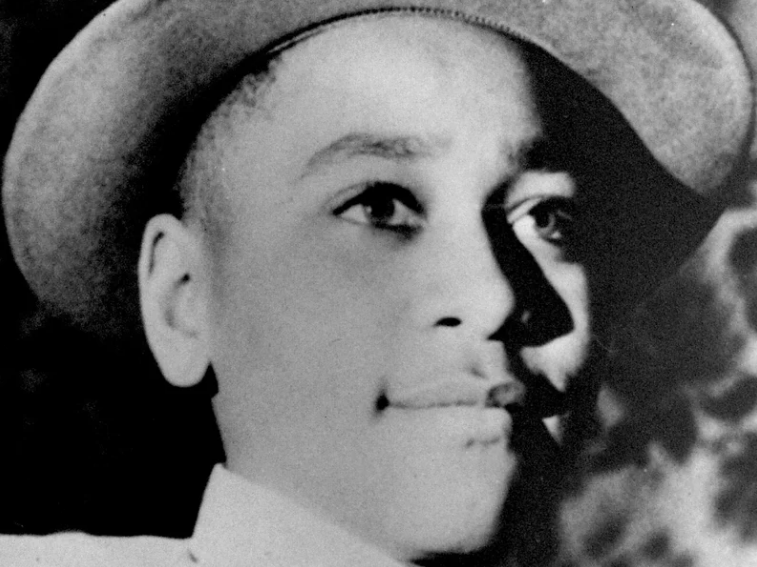
Emmett Till's family seeks the arrest of a woman after a 1955 warrant is found
June 29, 20229:04 PM ETA team searching a Mississippi courthouse basement for evidence about the lynching of Black teenager Emmett Till has found the unserved warrant charging a white woman in his 1955 kidnapping, and relatives of the victim want authorities to finally arrest her nearly 70 years later.
A warrant for the arrest of Carolyn Bryant Donham — identified as "Mrs. Roy Bryant" on the document — was discovered last week by searchers inside a file folder that had been placed in a box, Leflore County Circuit Clerk Elmus Stockstill told The Associated Press on Wednesday.
Documents are kept inside boxes by decade, he said, but there was nothing else to indicate where the warrant, dated Aug. 29, 1955, might have been.
"They narrowed it down between the '50s and '60s and got lucky," said Stockstill, who certified the warrant as genuine.
The search group included members of the Emmett Till Legacy Foundation and two Till relatives: cousin Deborah Watts, head of the foundation; and her daughter, Teri Watts. Relatives want authorities to use the warrant to arrest Donham, who at the time of the slaying was married to one of two white men tried and acquitted just weeks after Till was abducted from a relative's home, killed and dumped into a river.
"Serve it and charge her," Teri Watts told the AP in an interview.
Keith Beauchamp, whose documentary film "The Untold Story of Emmett Louis Till" preceded a renewed Justice Department probe that ended without charges in 2007, was also part of the search. He said there's enough new evidence to prosecute Donham.
Donham set off the case in August 1955 by accusing the 14-year-old Till of making improper advances at a family store in Money, Mississippi. A cousin of Till who was there has said Till whistled at the woman, an act that flew in the face of Mississippi's racist social codes of the era.
Evidence indicates a woman, possibly Donham, identified Till to the men who later killed him. The arrest warrant against Donham was publicized at the time, but the Leflore County sheriff told reporters he did not want to "bother" the woman since she had two young children to care for.
Now in her 80s and most recently living in North Carolina, Donham has not commented publicly on calls for her prosecution. But Teri Watts said the Till family believes the warrant accusing Donham of kidnapping amounts to new evidence.
"This is what the state of Mississippi needs to go ahead," she said.
District Attorney Dewayne Richardson, whose office would prosecute a case, declined comment on the warrant but cited a December report about the Till case from the Justice Department, which said no prosecution was possible.
Contacted by the AP on Wednesday, Leflore County Sheriff Ricky Banks said: "This is the first time I've known about a warrant."
Banks, who was 7 years old when Till was killed, said "nothing was said about a warrant" when a former district attorney investigated the case five or six years ago.
"I will see if I can get a copy of the warrant and get with the DA and get their opinion on it," Banks said. If the warrant can still be served, Banks said, he would have to talk to law enforcement officers in the state where Donham resides.
Arrest warrants can "go stale" due to the passage of time and changing circumstances, and one from 1955 almost certainly wouldn't pass muster before a court, even if a sheriff agreed to serve it, said Ronald J. Rychlak, a law professor at the University of Mississippi.
But combined with any new evidence, the original arrest warrant "absolutely" could be an important stepping stone toward establishing probable cause for a new prosecution, he said.
"If you went in front of a judge you could say, 'Once upon a time a judge determined there was probable cause, and much more information is available today,'" Rychlak said.
Till, who was from Chicago, was visiting relatives in Mississippi when he entered the store where Donham, then 21, was working on Aug. 24, 1955. A Till relative who was there, Wheeler Parker, told AP that Till whistled at the woman. Donham testified in court that Till also grabbed her and made a lewd comment.
Two nights later, Donham's then-husband, Roy Bryant, and his half-brother, J.W. Milam, showed up armed at the rural Leflore County home of Till's great-uncle, Mose Wright, looking for the youth. Till's brutalized body, weighted down by a fan, was pulled from a river days later in another county. His mother's decision to open the casket so mourners in Chicago could see what had happened helped galvanize the building civil rights movement of the time.
Bryant and Milam were acquitted of murder but later admitted the killing in a magazine interview. While both men were named in the same warrant that accused Donham of kidnapping, authorities did not pursue the case following their acquittal.
Wright testified during the murder trial that a person with a voice "lighter" than a man's identified Till from inside a pickup truck and the abductors took him away. Other evidence in FBI files indicates that earlier that same night, Donham told her husband at least two other Black men were not the right person.
article
Emmett Till's family seeks the arrest of a woman after a 1955 warrant is found : NPR
forum post
-
As a woman-founded and women-led company, our hearts are broken at the Roe v Wade overturn. Every woman and person who are able to be pregnant deserves the right to have autonomy over their own bodies.
As filmmakers, we champion womxn in our stories and fight for them more in our everyday world.
With 6 days remaining to our campaign, Filled With Magic productions will donate 50% the funds we raise from now to July 1 to local abortion funds in Florida and across the South.
Please help us spread the word as we stand with womxn.
— Moon Ferguson Founder & CEO of Filled With Magic Productions.
To support click the link
https://www.kickstarter.com/projects/moonferguson/criblore-a-horror-anthology/posts/3541694?ref=ksr_email_backer_project_update_registered_users
-
-
Regina King will play Shirley Chisholm
click read below to see my words
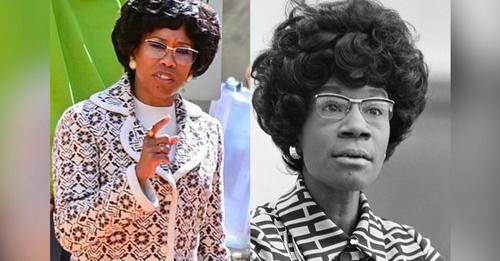
I will never forget one of Saint CHisholm's last sayings... I paraphrase, she said that the black community needs to focus on the financial sector in terms of moving the movement forward...funny how that hasn't happened. But, The timeline supports why it has not.
The history of all people in the USA is older than the USA. But, what is the initial history of the Black community in the USA concerning, exclusively, the USA?
Four groups: Enslaved/Dead in the great ocean/Free fought on the side of the colonies of britain/Free fought on the side of the british empire.
Now the Enslaved or Dead represent over ninety percent of the Black community at the time of the founding of the USA.
Fast forward, slavery ended circa 1865 so over ninety percent of Black people in the USA had no possible financial change of status in the USA absent a violent act towards whites. And while as enslaved people ,Black people were worked to death at gun point by White : people or terrorist or slavers or fiscal capitalist or americans or christians or jews or women or men or free individuals. Over ninety percent of Black people had zero financial possibility in the USA.
Now you will say from the end of slavery to the year two thousand and twenty two, which is the year this post was made, opportunity existed. But I quote MLK jr
MLK jr , said above, that the Black community went from over ninety percent having zero financial possibility. To , over ninety percent of Black people being dropped into a completely disadvantaged financial situation, meaning no land ownership/no knowledge of the laws of the usa/no ability to read or write in any language/no bank account. So yes, over ninety percent of Black people went from zero financial possibility by the white whip to free people. But, they were surrounded by a white community that in its individuals owned land/had knowledge of the usa/could read or write/had bank accounts. So the Black community was totally diadvantaged and never had the chance to gain land by killing others, farm land by enslaving others, earn illegal profits during a government ban, make wealth in abusing humans outside the usa. White wealth does not come from paid labor merit, it comes from slavery or genocide, murdering or enslaving others. Black people have never done that in the USA.
Now we reach modernity and the Black community that has earned every penny in the usa through paid labor absent any favors, needs a financial era at least once like whites had multiple times. But, the problem with that need is all the ways whites had those times are now illegal.
I concur to SHirley Chisholm, but the problem is the Black community in the USA has to do all within a legal framework that never brings great wealth to a larger community.
So it may take a very long time for the Black community in the USA to ever have a majority financial golden moment. And just cause some may suggest the following. Tulsa wasn't a golden age. The problem with Tulsa is like the free blacks who fought on the side of the colonies, their freedom or money doesn't reflect the honest condition of the majority of black people in the usa.
https://www.blackenterprise.com/first-look-of-regina-king-transformation-as-first-black-congresswoman-shirley-chisholm-in-new-film-shirley/
-
'I depict mundane images because the life of a Black woman is just like any other': Billie Zangewa on anatomy, Kusama and celebrating imperfections
The South African artist tells us about her favourite books, music and artists on the A brush with… podcast
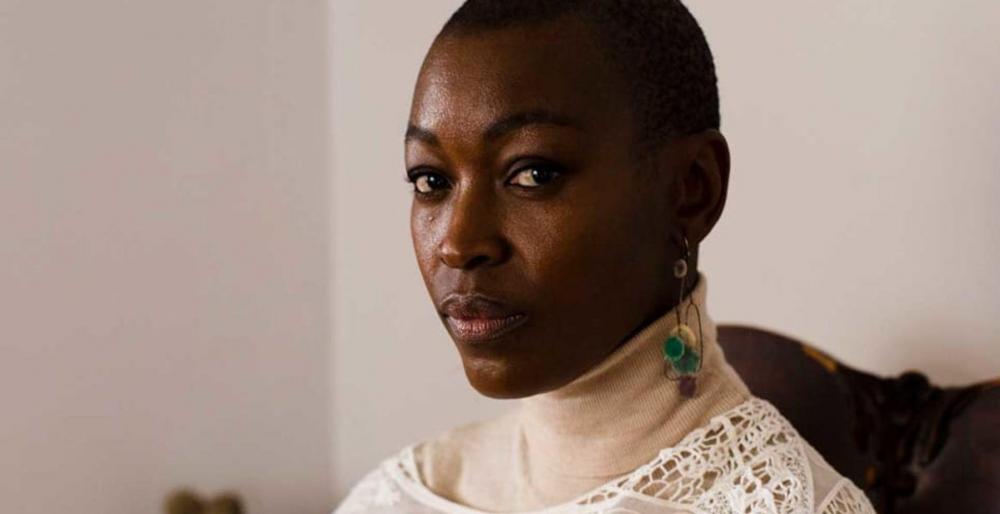
Billie Zangewa.
Photo: Andrew Thomas Berry. © Art basel
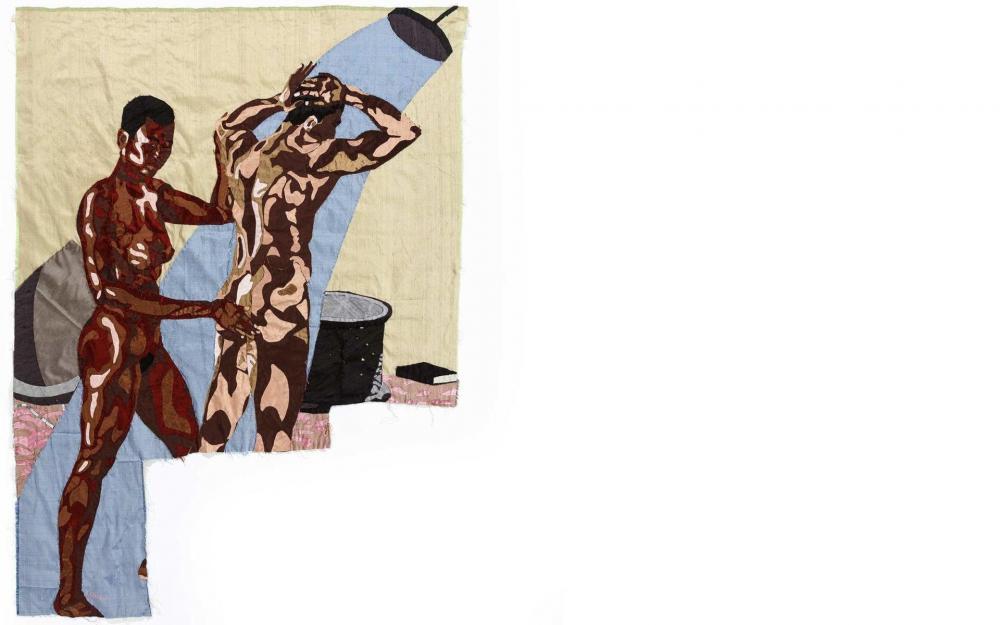
Billie Zangewa, Domestic Scene (2016). Courtesy of the artist and Lehmann MaupinBillie Zangewa on... her fascination with the human form
"When I was at art school I loved life drawing. My son once asked me: 'Mom, how come when you do bodies, you can see the bones and muscles?'. And I replied: 'When I was at university I was completely thrilled by that little bit of science in art.' We would draw bones by themselves, under flesh, and then muscles by themselves and then under the flesh. So that really stuck with me and now when I look at the human form, I'm always seeing the nuance of the light and the protruding shapes that are coming from inside the body."
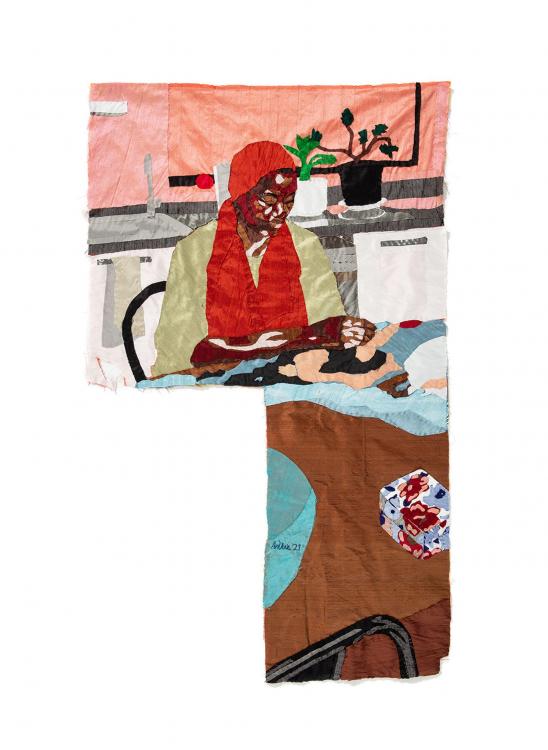
Billlie Zangewa's Serious, 2021.
Courtesy the artist and Lehmann Maupin, New York, Hong Kong, Seoul, and London... why she depicts mundane images in her work
"I knew from my childhood that being Black and female was going to be a very difficult journey for me. And that a lot of people were going to project their fantasies and desires onto me and that they would not see me as a person, they wouldn't be able to empathise with my daily struggles, or even to understand that I had feelings. That is one of the reasons why I choose to depict such mundane daily images, because what I am trying to say is that a Black woman is just like any other person. We go through the same routine every day, we go through the same struggles. We're all human."

... her favourite contemporary artist"Yayoi Kusama is incredible—I honestly don't think that anybody can equal her.There are lots of brilliant artists, but I think she in particular has an incredible focus and her work just gels together. She doesn't seem like she's going off over there and then going in a different direction. It always seems like she's expanding on a theme, and I think that's what makes her really incredible."

Installation view of Billie Zangewa: Flesh and Blood at Lehmann Maupin, Seoul.
Courtesy the artist and Lehmann Maupin, New York, Hong Kong, Seoul, and London... the process behind her cut out silk works
"Those kind of uneven, even edges are really works speaking to each other. So I would have cut out a piece [of silk] for a previous work, which would have created a negative space. [...] But it's only until the work reveals itself to me that I think that piece of fabric is going to be perfect for what I'm trying to say. So I do keep it quite spontaneous. I'm not trying to force any thing into anything. I really enjoy those irregular edges because it speaks to society and to individuals, about how we have wounds, scars and certain thought patterns that don't serve us well. I'm speaking to everyone's combination of the perfect and the imperfect."
• For the full interview with the artist, listen to our podcast, A brush with... Billie Zangewa < https://www.theartnewspaper.com/2021/11/17/a-brush-with-billie-zangewa > , which is available on the usual podcast platforms. < https://plinkhq.com/i/1525997434?to=page > A brush with… series 7 runs from 17 November-15 December 2021, with episodes released on Wednesdays. This episode is sponsored by Bloomberg Connects.
• Billie Zangewa: Running Water < https://www.lehmannmaupin.com/exhibitions/billie-zangewa3 > , Lehmann Maupin London, until 8 January 2022; Flesh and Blood < https://www.lehmannmaupin.com/exhibitions/billie-zangewa2 > , Lehmann Maupin Seoul, from 18 November-15 January 2022; Thread for a Web Begun < https://www.moadsf.org/exhibition/billie-zangewa-thread-for-a-web-begun/> , Museum of the African Diaspora, San Francisco, until 27 February.
-
Parabens O Rei, the King, O perola Negra, the Black Pearl
Pele
title: the legend pele
artist: abualbara69
https://www.deviantart.com/abualbara69/art/The-Legend-Pele-863420736title: Pele art
artist: niezamcomic
https://www.deviantart.com/niezamcomic/art/Pele-Art-733993470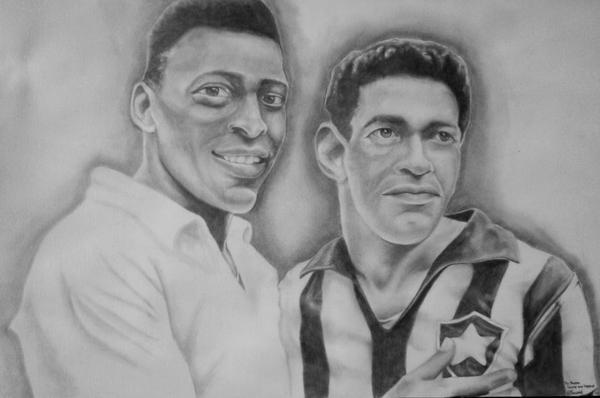
title: legends <pele with his best mate, saint garrincha>
artist: eurofoxx
https://www.deviantart.com/eurofoxx/art/Legends-52576900













